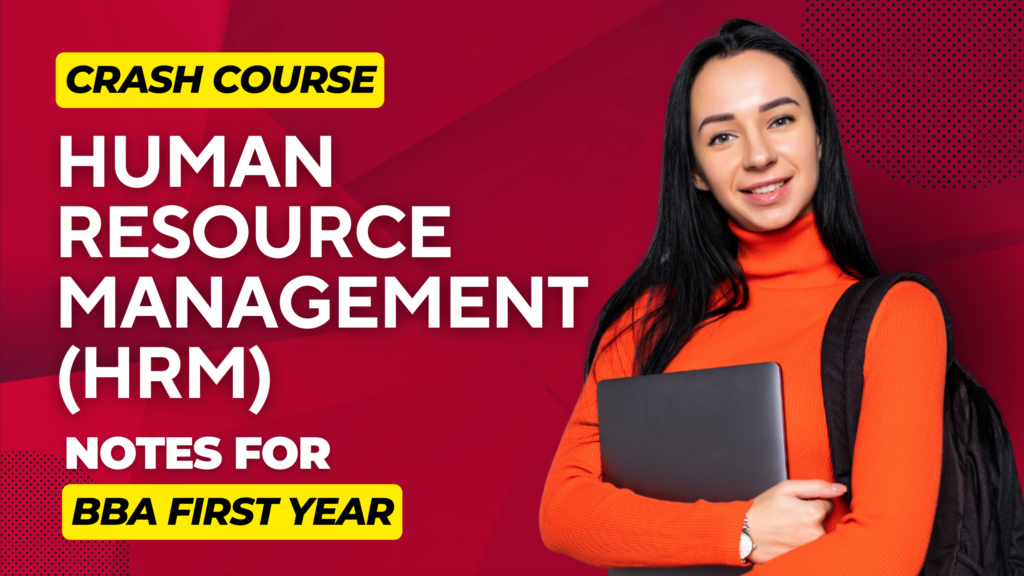Introduction to Human Resource Management (HRM)
Definition: Human Resource Management (HRM) is the strategic approach to managing people effectively for performance enhancement and development.
Objectives of HRM:
- Achieve organizational goals.
- Enhance employee productivity and job satisfaction.
- Ensure compliance with employment laws.
Functions of HRM:
- Recruitment and Selection.
- Training and Development.
- Performance Management.
- Compensation and Benefits.
- Employee Relations.
- Health and Safety.
2. HR Planning and Job Analysis
- HR Planning:
- Ensuring the right number of people with the right skills are in the right place at the right time.
- Steps include forecasting demand, assessing supply, and balancing supply and demand.
- Job Analysis:
- Process of gathering, documenting, and analyzing information about jobs.
- Job Description: A detailed account of job duties, responsibilities, and requirements.
- Job Specification: Detailed list of qualifications, skills, and experience needed for a job.
3. Recruitment and Selection
Recruitment:
- Process of attracting suitable candidates to apply for job openings.
- Sources include internal (promotions, transfers) and external (job boards, social media, agencies).
Selection:
- Process of evaluating and choosing the best candidate for a job.
- Steps include screening applications, conducting interviews, testing, and background checks.
4. Training and Development
Training:
- Enhancing employees’ skills and knowledge for their current job roles.
- Methods include on-the-job training, workshops, e-learning, and simulations.
Development:
- Preparing employees for future roles and responsibilities.
- Focuses on broader skills such as leadership, communication, and strategic thinking.
5. Performance Management
Performance Appraisal:
- Regular review of an employee’s job performance and overall contribution to the company.
- Methods include self-assessment, peer review, and manager evaluation.
Performance Improvement Plans (PIPs):
- Structured plans aimed at helping underperforming employees improve their performance.
Key Performance Indicators (KPIs):
- Specific metrics used to evaluate an employee’s effectiveness and efficiency.
6. Compensation and Benefits
Compensation:
- Financial and non-financial rewards given to employees.
- Includes salary, bonuses, commissions, and incentives.
Benefits:
- Non-monetary rewards such as health insurance, retirement plans, paid time off, and wellness programs.
Total Rewards Strategy:
- Integrating compensation and benefits with personal growth opportunities and work environment.
7. Employee Relations
Labor Relations:
- Managing the relationship between management and the workforce.
- Involves negotiations with unions, handling grievances, and ensuring compliance with labor laws.
Employee Engagement:
- Ensuring employees are committed to their work and the organization.
- Strategies include clear communication, recognition programs, and career development opportunities.
Conflict Resolution:
- Addressing and resolving workplace disputes in a fair and timely manner.
- Techniques include mediation, arbitration, and negotiation.
8. Health, Safety, and Wellness
Workplace Safety:
- Ensuring the physical well-being of employees.
- Compliance with Occupational Safety and Health Administration (OSHA) regulations.
Employee Wellness Programs:
- Initiatives to promote health and well-being include fitness programs, mental health support, and healthy eating plans.
Risk Management:
- Identifying and mitigating risks to employee health and safety.
9. Legal and Ethical Issues in HRM
Employment Law:
- Regulations governing employment practices, including hiring, wages, workplace safety, and discrimination.
Equal Employment Opportunity (EEO):
- Ensuring no discrimination based on race, color, religion, sex, or national origin.
Ethical HR Practices:
- Upholding integrity, fairness, and transparency in all HR activities.
Compliance:
- Adhering to laws and regulations relevant to HR functions and avoiding legal liabilities.
10. Emerging Trends in HRM
Technology in HR:
- Use of HR Information Systems (HRIS) and artificial intelligence for talent management, analytics, and process automation.
Diversity and Inclusion:
- Promoting a diverse workforce and inclusive culture to enhance creativity and performance.
Remote Work:
- Managing virtual teams and ensuring productivity and engagement in remote work settings.
Sustainability:
- Integrating corporate social responsibility (CSR) into HR practices.
These notes provide a foundational understanding of Human Resource Management for first-year BBA students, encompassing key concepts, practices, and emerging trends. Use them as a guide for further exploration and study in the field of HRM.

